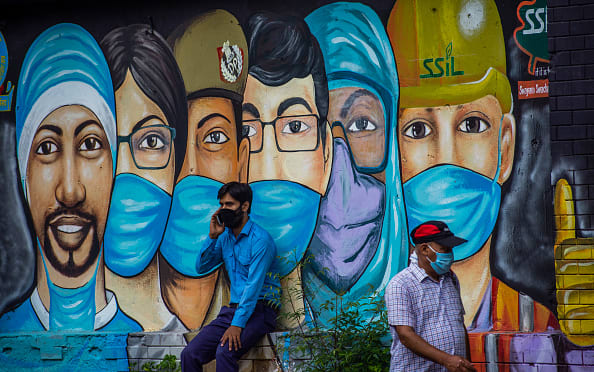
Pedestrians wearing protective face masks in front of a mural in New Delhi, India on July 21, 2020.
Yawar Nazir | Getty Images
More than half a year after the coronavirus disease — or Covid-19 — first emerged in Asia Pacific, new infections are still climbing sharply in some parts of the region.
Some countries including India, Indonesia and the Philippines have not reached the peak of their first wave of coronavirus, while others such as Australia and Japan appear to be experiencing a second wave of infections, data compiled by John Hopkins University indicated.
Globally, the virus has infected more than 15.1 million people across 188 countries and regions, killing over 622,000, Hopkins data showed.
The charts below show the infection curves in five Asia Pacific countries with accelerating Covid-19 cases.
India
- Covid-19 tally: 1,193,078 confirmed cases and 28,732 deaths, according to Hopkins data as of July 21
Last week, India became the third country — after the U.S. and Brazil — to record more than 1 million cumulative cases of Covid-19, according to Hopkins data.
The government of Prime Minister Narendra Modi implemented a strict nationwide lockdown at the end of March and started to lift some measures in early June. But the number of infections has continued to accelerate, with epidemiologists warning that the outbreak in India could still be months away from its peak, reported Reuters.
Indonesia
- Covid-19 tally: 89,869 confirmed cases and 4,320 deaths, according to Hopkins data as of July 21
Over the weekend, Indonesia overtook China to become the country with the highest number of confirmed cases in East Asia, reported Reuters.
Indonesia is the world’s fourth most populous country with over 273 million people and is still in the middle of its first wave.
In the last few months, experts have warned that many cases in the country may have gone undetected given its lag in testing. Not helping the outbreak is the government’s reluctance to impose stricter nationwide containment measures, even though local authorities are allowed to implement lockdowns to slow the virus spread in their respective provinces.
Indonesian President Joko Widodo reportedly said last week that the country’s outbreak is expected to peak in August or September. He also said he’s pushing his ministers to work harder to control the country’s coronavirus outbreak.
Philippines
- Covid-19 tally: 70,764 confirmed cases and 1,837 deaths, according to Hopkins data as of July 21
Other than China, where Covid-19 first emerged, the Philippines was among the earliest countries to impose a lockdown on its hardest-hit areas.
The government’s lockdown on Luzon — the country’s most populous island and home to capital city Manila — was imposed in mid-March before being gradually eased starting in June.
But the number of new infections spiked after that, with people reportedly flouting social distancing rules. That caused the Philippine government to tighten those measures again in areas where cases have risen, including Manila, according to a Reuters report.
The tough-talking Philippine President Rodrigo Duterte this week threatened to arrest anyone not wearing a mask, after warning in April that those violating lockdown rules could be shot. Meanwhile, health authorities have aimed to increase the country’s testing capacity to 32,000 to 40,000 people a day — up from the current 20,000 to 23,000, reported Reuters.
Japan
- Covid-19 tally: 26,463 confirmed cases and 988 deaths, according to Hopkins data as of July 21
Japan is one of the countries in Asia Pacific that has recorded a resurgence in coronavirus cases after earlier success in slowing down the number of infections. However, authorities in the country have refrained from labeling the recent rise in cases as a second wave.
Most of the newly emerged infections have been concentrated in Tokyo, the capital city of Japan. The spike in cases has come after the government in late May ended a nationwide state of emergency aimed at curbing the spread of Covid-19.
Despite the rise in cases, Japanese officials have repeatedly said there’s no need to declare a new state of emergency.
Instead, the government on Wednesday kicked off a national tourism campaign in an attempt to revive its battered economy. The move has reportedly come under criticism amid fears that domestic travel would spread the virus even more.
Australia
- Covid-19 tally: 12,894 confirmed cases and 128 deaths, according to Hopkins data as of July 21
Like Japan, Australia is experiencing an uptick in the number of new cases after the outbreak appeared to be contained earlier.
Victoria state, home to the country’s second-most populous city Melbourne, has accounted for most of the new cases reported in the last few weeks. That led authorities to reinstate a partial lockdown on Melbourne and made face masks mandatory for residents when they leave their homes.
Meanwhile, neighboring states sealed their borders with Victoria.
Authorities have reportedly blamed complacency for the flare up in Covid-19 infections. Victoria Premier Daniel Andrews said more than 2,000 people went on with their daily lives as normal after testing positive earlier this month, reported Reuters.
Health authorities have warned that it could take weeks before the new outbreak is contained.
Source: CNBC
